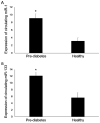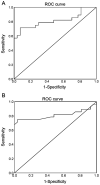Expression and clinical significance of miR-1 and miR-133 in pre-diabetes
- PMID: 33585035
- PMCID: PMC7873585
- DOI: 10.3892/br.2021.1409
Expression and clinical significance of miR-1 and miR-133 in pre-diabetes
Abstract
Pre-diabetes represents an intermediate state of altered glucose metabolism between normal glucose levels and type 2 diabetes mellitus (T2D), and is considered a significant risk factor for the development of T2D and related complications. Early detection of pre-diabetes may allow for the use of timely and effective treatment strategies to prevent its progression. Circulating microRNAs (miRNAs/miRs) that reflect changes in diabetes-related tissues, including the pancreas, liver, skeletal and heart muscle, and adipose tissue are promising biomarkers of disease progression. In our previous study, it was demonstrated that the cardiac and skeletal muscle specific miR-1 and miR-133 are upregulated in the blood of patients with T2D and cardiovascular disease. Since both miRNAs have been shown to be implicated in insulin resistance, an important feature of pre-diabetes, we hypothesised that their expression may be increased prior to clinical diagnosis of T2D, and may thus serve as biomarkers for pre-diabetes. The expression levels of circulating miRNAs were evaluated by reverse transcription-quantitative PCR in whole blood samples from 55 subjects, including 28 pre-diabetes individuals with impaired fasting glucose (FG) and impaired glucose tolerance, and 27 healthy controls. The individuals with pre-diabetes exhibited significantly higher expression levels of miR-1 and miR-133 compared with the controls (P<0.05). Target prediction search revealed that both miR-1 and miR-133 target several pathways involved in the pathophysiology of diabetes. Pearson's correlation analysis revealed that the two miRNAs were positively correlated with blood glucose parameters, including FG, 2-h oral glucose tolerance test and glycated haemoglobin A1c levels, as well as with insulin resistance (P<0.05). Multivariate logistic regression analysis revealed that the two miRNAs were significantly and directly associated with pre-diabetes, and this association remained significant after adjustment for several confounding variables (P<0.05). Moreover, linear regression analysis showed that the Homeostatic Model Assessment-Insulin Resistance was the only significant predictor to be significantly associated with both miRNAs (P<0.05). In discriminating pre-diabetes individuals from healthy controls, the area under the curves (AUCs) of the receiver operating characteristic curves (ROCs) were 0.813 and 0.810 for miR-1 and miR-133 respectively (P<0.05). Despite the relatively small number of participants, the present study showed for the first time that circulating levels of miR-1 and miR-133 were increased in individuals with pre-diabetes, and they were associated with important features of pre-diabetes. Thus, they may serve as clinical biomarkers for the early-stages of T2D.
Keywords: biomarkers; circulating miRNAs; miR-1; miR-133; pre-diabetes.
Copyright © 2020, Spandidos Publications.
Figures


Similar articles
-
Peripheral blood microRNA-15a is a potential biomarker for type 2 diabetes mellitus and pre-diabetes.Mol Med Rep. 2015 Nov;12(5):7485-90. doi: 10.3892/mmr.2015.4416. Epub 2015 Oct 1. Mol Med Rep. 2015. PMID: 26460159
-
Decreased expression of circulating microRNA-126 in patients with type 2 diabetic nephropathy: A potential blood-based biomarker.Exp Ther Med. 2016 Aug;12(2):815-822. doi: 10.3892/etm.2016.3395. Epub 2016 May 26. Exp Ther Med. 2016. PMID: 27446281 Free PMC article.
-
Circulating miR-146a, miR-34a and miR-375 in type 2 diabetes patients, pre-diabetic and normal-glycaemic individuals in relation to β-cell function, insulin resistance and metabolic parameters.Clin Exp Pharmacol Physiol. 2019 Dec;46(12):1092-1100. doi: 10.1111/1440-1681.13147. Epub 2019 Aug 20. Clin Exp Pharmacol Physiol. 2019. PMID: 31355469
-
Circulating microRNAs as biomarkers in hepatocellular carcinoma screening: a validation set from China.Medicine (Baltimore). 2015 Mar;94(10):e603. doi: 10.1097/MD.0000000000000603. Medicine (Baltimore). 2015. PMID: 25761179 Free PMC article.
-
MicroRNAs in islet hormone secretion.Diabetes Obes Metab. 2018 Sep;20 Suppl 2:11-19. doi: 10.1111/dom.13382. Diabetes Obes Metab. 2018. PMID: 30230181 Review.
Cited by
-
Regulation of HIF-1 by MicroRNAs in Various Cardiovascular Diseases.Curr Cardiol Rev. 2023;19(5):51-56. doi: 10.2174/1573403X19666230330105259. Curr Cardiol Rev. 2023. PMID: 37005512 Free PMC article.
-
Exosomes: New Insights into the Pathogenesis of Metabolic Syndrome.Biology (Basel). 2023 Dec 1;12(12):1480. doi: 10.3390/biology12121480. Biology (Basel). 2023. PMID: 38132306 Free PMC article. Review.
-
Comparative effects of metformin and varying intensities of exercise on miR-133a expression in diabetic rats: Insights from machine learning analysis.Biochem Biophys Rep. 2024 Nov 23;40:101882. doi: 10.1016/j.bbrep.2024.101882. eCollection 2024 Dec. Biochem Biophys Rep. 2024. PMID: 39649797 Free PMC article.
-
Human miR-1 Stimulates Metabolic and Thermogenic-Related Genes in Adipocytes.Int J Mol Sci. 2024 Dec 31;26(1):276. doi: 10.3390/ijms26010276. Int J Mol Sci. 2024. PMID: 39796132 Free PMC article.
-
Identification of circRNAs Associated with Adipogenesis Based on RNA-seq Data in Pigs.Genes (Basel). 2022 Nov 7;13(11):2062. doi: 10.3390/genes13112062. Genes (Basel). 2022. PMID: 36360299 Free PMC article.
References
LinkOut - more resources
Full Text Sources
Other Literature Sources
